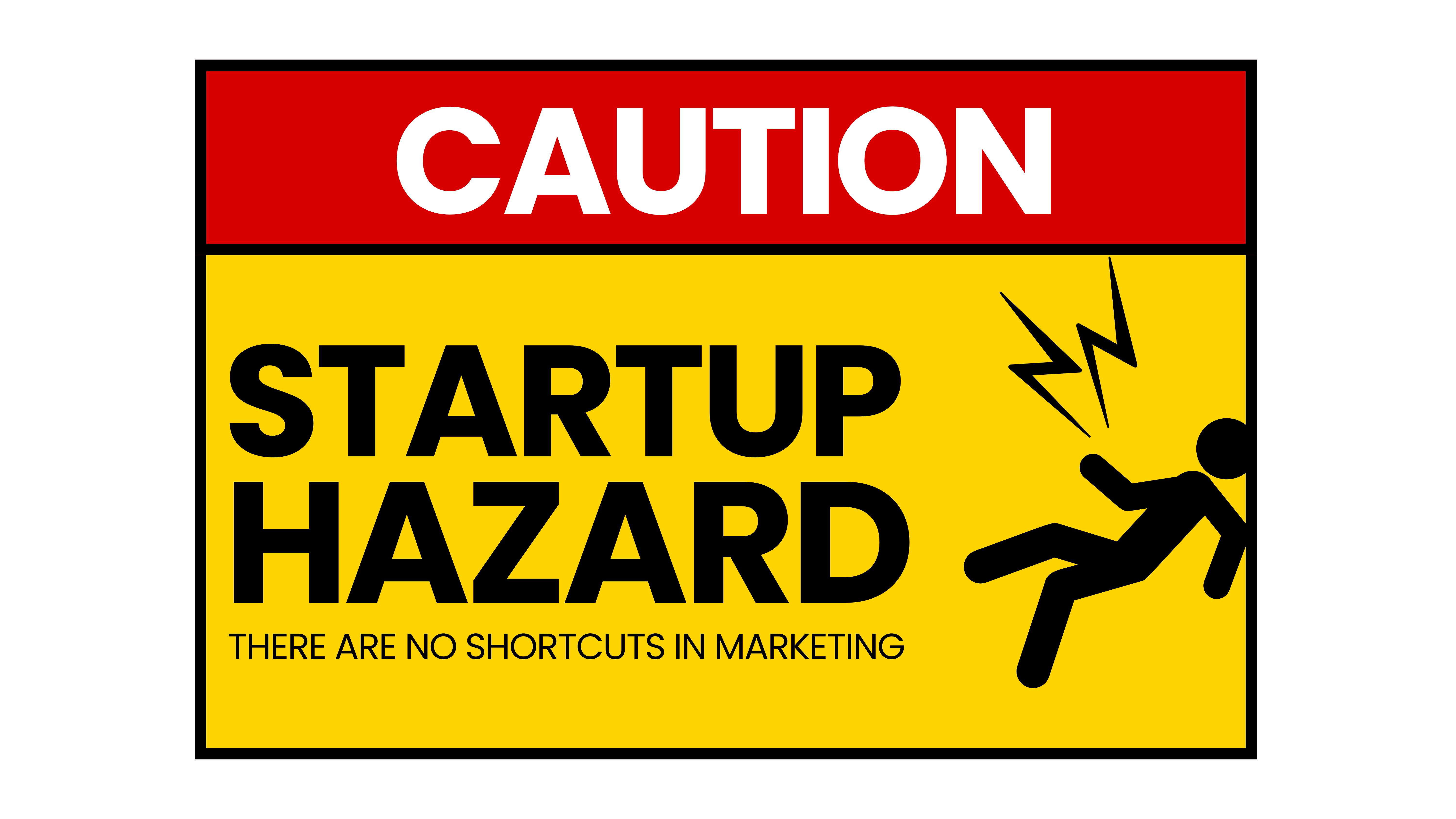I’m not a designer. I’m a founder. I don’t care about kerning—I care about shipping.
So when Canva promised clean design with zero friction, I was sold. No agencies. No Figma drama. For $120, we looked like a Series B startup while still figuring out what our product did.
Fantastic.
Then one day, we tried starting from scratch. No templates, no guardrails, just an idea and a blank slide.
Nothing came out.
This isn’t a Canva teardown, just a warning: design tools can quietly erase your marketing instincts—until all you know how to do is make things that look like marketing.
What Convenience Takes From You
The damage of Canva isn’t aesthetic. It’s psychological.
1. Canva Cuts Strategy Gets Cut Out Of The Sequence
Before Canva, strategy came first, because it had to. You couldn’t design anything until you knew what you were trying to say. Messaging shaped layout. Insight shaped visual hierarchy. The thinking determined the design.
Canva flips that sequence. You start with the template. Then you backfill the message. You tweak colors, swap fonts, drag headlines—then try to figure out what it’s saying. The visuals lead. Strategy follows, if it shows up at all.
Canva severs the link between message and design—so your team builds around layout, not logic.
2. Canva Collapses Your Ability to Prioritize
Before Canva, you had to choose your battles. Design was both time consuming and expensive, so the right to create had to be earned. You had to make the case: Why this asset? Why now? What’s the point?
That design complexity acted as a filter, letting you prioritize what mattered most.
Now everything takes 10 minutes. So everything feels equal.
You design with the same energy for a homepage, an investor update, a LinkedIn post. You lose the instinct to ask: Is this a two-hour task or a two-week one? You forget how to feel the weight of things.
Canva collapses your ability to prioritize—because when everything is equally easy to create, nothing feels important enough to think deeply about.
3. Canva Hides Brand Decay in Plain Sight
Brand decay doesn’t happen through earth-shattering flops. It happens through hundreds of tiny, unintentional decisions:
• One more font
• A slightly different tone of green
• A new layout for this week’s post
• A promo slide that wasn’t run through anyone.
By the end of the quarter, you’ve unintentionally rebranded five times. It gives you so many options, your brand dies by a thousand optimizations.
4. Canva Makes Bad Ideas Look Legit—and Misleads You When They Fail
Canva designs are pretty good—a little too good.
Drop weak messaging into a sleek template, and suddenly it feels solid. Confusing copy looks clean. Half-baked ideas look presentable.
And when the results suck, no one questions the content—because the container looked so convincing. You just assume the colors are off.
The layout needs adjusting. The design needs a “refresh.”
Canva makes weak marketing look wonderful—and when it flops, you end up fixing the wrong thing. You don’t rewrite. You redesign. And the cycle repeats. Quietly. Expensively. Ineffectively.
5. Canva Trains You to Avoid Anything That Doesn’t Fit the Template
Over time, you stop chasing ideas that don’t already have a layout.
You don’t write the weird essay post—because it won’t look good in a carousel. The strange campaign? No, because there’s no ready-made design for that. You steer clear of new formats simply because Canva makes them difficult to produce.
You default to what fits, not what resonates. And over time, the things that don’t fit the mold don’t feel worth pursuing at all.
Canva shapes how you present ideas, and also limits which ones you’re willing to have.
6. Canva Warps Your Team’s Understanding of Marketing
When everyone can drag and drop, everyone thinks they “get” marketing. When you finally try to hire real marketers, real creatives, real thinkers—your team resists.
“Isn’t this just making slides?”
“Didn’t we already figure out the brand?”
“Can’t we just use the template?”
Canva makes marketing feel like something anyone can do—sure, if your definition of marketing is pixel shuffling. But real marketing isn’t decorating. It’s positioning, insight, narrative, timing, channel, taste. And once your team is trained to value polish over depth, it’s hard to reintroduce the real thing.
Canva democratizes marketing execution at the cost of respect for the discipline itself. By the time you need the real thing, your team doesn’t believe it matters.
The Cases That Justify Convenience
Canva is brilliant. But it only works if you know exactly what you’re using it for. Here are the legitimate, high-leverage use cases—where Canva becomes an asset, not a marketing assassin.
1. When You’re Just Trying to Exist Online Long Enough to Get Feedback
You’re early. Resources are tight. The idea might pivot by next week. But you still need to throw out a landing page, run a quick ad, or test a message—just to see if anyone bites. You just need something that looks decent enough to get feedback, but you don’t have a budget for a designer.
That’s where Canva fits. It’ll give you the ammunition you need to figure out if you’ve actually built something worth marketing. But don’t bother shopping around to find the perfect template. If your product positioning and messaging are off, no template will save you.
2. When You Know Exactly What You Want—and CBF Learning Illustrator
This is the sweet spot.
You’ve got the vision in your head. You’ve done the hard part: the copy works, the hook is tested, the positioning is sharp. You know the vibe. You just don’t want to spend 5 hours watching Adobe tutorials or begging a designer to “move the logo 10 pixels left.”
Canva works when it’s used as a tool of translation, not inspiration. When you’re not there to be inspired by templates, just to recreate something already clear in your mind.
3. When You Have a Brand Identity—But No Time to Police It
You’ve defined the voice. You’ve chosen the color system. You’ve aligned on tone. But every day someone on the team is creating something—and you don’t have time to approve it all.
Canva works when your job as a founder or brand lead shifts from creator to enforcer. You’re not asking Canva to invent your brand. You’re asking it to protect it while you’re doing 10 other things. And their Brand Kit function lets you do just that.
It’s not a design tool at this point—it’s a compliance tool.
4. When You’re Trying to Make Strategy Feel Real
Startups move fast, but alignment moves slow—especially when ideas are abstract. For example: a new vibe, or campaign that lives in your head but hasn’t clicked for the team yet. In these moments, Canva helps you make things real enough for people to react to.
You’re not shipping externally, just creating internal clarity.
Sometimes, the only way to get buy-in is to show—not tell. Use Canva when the team needs to see the future before they believe in it.
5. When You Need to Dress Up Something Disposable
Not everything you make is sacred. Some things are just… necessary.
A partner deck you’ll use twice. A recruiting asset for a specific role. A last-minute slide for a VC that’ll never read past page five.
These things still need to look good—but they’re temporary, tactical, and forgettable by design.
That’s when Canva makes sense. It helps you not overthink the things that don’t deserve to slow you down. It’s not for your best ideas. It’s for the ones that don’t need to be.
Use Canva when the work needs to look polished—but only needs to live for a week.
Final Thoughts: Canva Is a Controlled Substance
My Canva subscription’s still active. I use it. I love it. But I treat it like a prescription drug.
In the chaos of early-stage building—when your product’s half-broken, your team’s underwater, and your messaging is mush—Canva gives you one part of the company that looks clean.
So you keep fixing that layer. The visual one. The easy one. But that’s sedation, not progress.
Canva can help, as long as you don’t let it numb the parts of the business that actually need your attention.
So use it. Just don’t abuse it.












